by Michael Riddick
Preview / download PDF in High Resolution
THE “GREAT SCHOOL” OF GUGLIELMO DELLA PORTA
While a quantity of objects have been reasonably attributed to Guglielmo della Porta (1515-77), less attention has been given to the distinction of his collaborators. As a result, various artworks have doubtless been given Guglielmo’s signature authorship while they could instead be the workmanship of qualified assistants working from his models and designs.
In the survey of art historical literature, observing the distinction between individual craftsmen in a workshop has been an arduous undertaking with attributions debated for great lengths of time and few documents available to definitively confirm artistic authorship. Adding to this complexity are the diverse roles assumed by workshop assistants as well as the succession of ownership and diffusion of a workshop’s models which can make secure attributions virtually impossible.
We could compare this art historical maze with the past century of research invested in delineating the evident qualities that distinguish the workmanship of assistants operating in Giambologna’s (1529-1608) workshop: Antonio Susini, Pietro Tacca (1577-1640), Adriaen de Vries (1560-1626), et al. It is expected the artists active in Guglielmo’s workshop will be equally discussed in coming decades, a process first initiated by Werner Gramberg and Ulrich Middledorf who made great advancements in our understanding of Guglielmo’s output. It is the present author’s hope that the observations and ideas presented in this series of articles, tentative as they might be at times, may serve as a clarifying step in the course of understanding not just Guglielmo himself but also the distinct work of those with whom he collaborated.
Rosario Coppel commented, “A comparative study has yet to be made between Guglielmo’s documented works and those of his workshop assistants.”[1] It is this challenge of being categorical about the individual artists in Guglielmo’s circle that the present author adopts as the role of this series of articles concerning the “Gran Scuola” of Guglielmo.[2]
_____

RECONSTITUTING A CRUCIFIX BY GUGLIELMO DELLA PORTA AND HIS COLLEAGUES
A crucifix model presently attributed to Jean Boulogne (called Giambologna, 1529-1608) should instead be restored to its earlier association with Guglielmo della Porta (1500-77) on account of documentary and stylistic problems. The crucifix became associated with Giambologna when a silver cast example from the Palazzo Apostolico in Loreto (Fig. 01) was exhibited in 1978-79 in London, Edinburgh and Vienna as part of a comprehensive exhibit of the artist’s oeuvre.[3]
The Loreto crucifix was included in the exhibit due to its association with a document thought to connect it with Giambologna. A 9 April 1583 letter to the Duke of Urbino from Simone Fortuna cites four crucifixes by Giambologna that had been respectively given to King Phillip II of Spain (1527-98), Pope Pius V (1504-72), Grand Duke Francesco I (1541-87) and the Duchess Joanna of Austria (1547-78). Fortuna describes the crucifixes as made of silver, copper or bronze. Their size is described as a little less than two palmi in height (approximately 44 cm).[4]
Joanna is documented at Loreto in 1573.[5] A 1597 source indicates that during her pilgrimage she donated an altar service inclusive of a pair of silver candlesticks and a silver crucifix mounted to an ebony cross.[6] Tradition has presumed the silver crucifix at Loreto is the example donated by Joanna and is therefore the crucifix by Giambologna that is mentioned in Fortuna’s letter.[7]
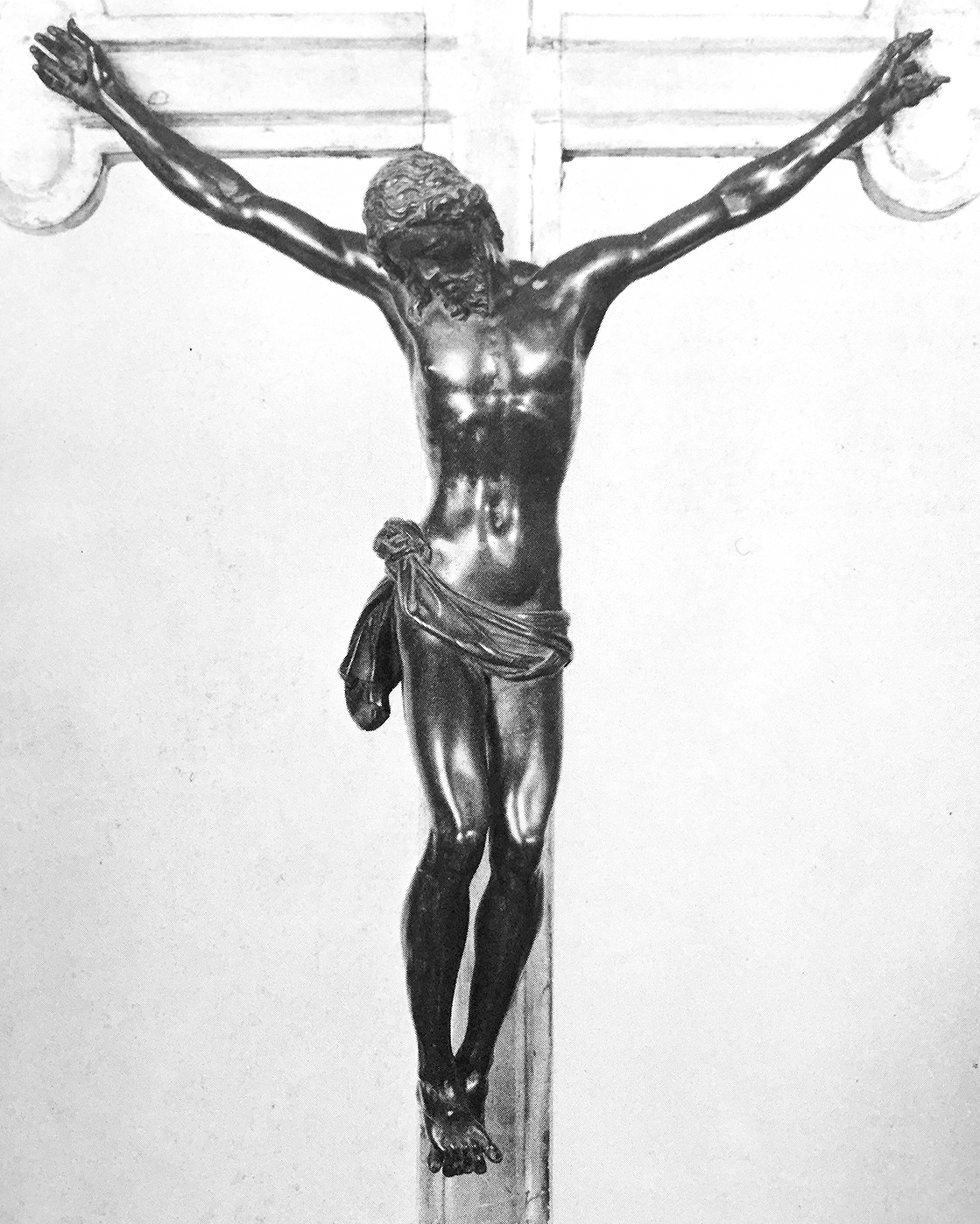
However, there are several problems related to the suggestion that the Loreto crucifix was the one Joanna had received from Giambologna. From Fortuna’s letter it is surmised that Giambologna was producing crucifixes by 1572 because one of the recipients, Pope Pius V, died in September of that year and must have received his before then. However, we do not know when Joanna specifically received her example[8] nor do we know what specific metal it was cast in.[9] The next earliest documentary evidence we have for Giambologna’s production of crucifixes is in 1578 for Cardinal Ferdinando de’ Medici (1559-1609) in Rome.[10] [11] [12] A document also indicates Giambologna’s assistants were tasked with casting crucifixes using his models as early as 1581. Two silver casts were prepared that year by Adriaen de Vries (1560-1626) for delivery to Spain.[13] The earliest secure sources for which we have a surviving visual example of Giambologna’s crucifixes are the small-scale examples he executed in the late 1580s, namely those at the Florentine convents of Santa Maria degli Angiolini[14] (Fig. 02) and San Marco, before 1588,[15] and his larger life-size corpora of the early 1590s such as the one Giambologna made for the Grand Duke Ferdinando I of Bavaria, ca. 1593-95 (Fig. 12) or the crucifix for the Cappella della Madonna del Soccorso at the Basilica della Santissima Annunziata in 1594 (Fig. 13).
While the possibility remains that Joanna could have had in her possession a silver crucifix by Giambologna in 1572 it could not have been the Loreto crucifix because its height is only 23.8 cm, inconsistent with the size of Giambologna’s crucifixes described in Fortuna’s letter. In addition to the discrepancy in size there is another immediate visual problem with the strength and fleshy-weight of the Loreto crucifix when compared with Giambologna’s known crucifixes which are slender and refined in their countenance.
ANTONIO GENTILI DA FAENZA AND GUGLIELMO’S CRUCIFIX PROTOTYPE
In 1961 a gilt silver cast of the Loreto corpus-type was originally attributed to Guglielmo’s colleague, Antonio Gentili da Faenza by Werner Gramberg, to whom the crucifix belonged.[16] Soon after the association of the Loreto crucifix with Giambologna, Ulrich Middeldorf contended that the Loreto crucifix, if cast by Giambologna, used a model by Guglielmo for its execution.[17] Beatriz Chadour, in her thesis on Gentili’s oeuvre also considered the Gramberg crucifix a cast made by Gentili after Guglielmo’s model, commenting also on its similarities with two other crucifixes cast by him and reproducing Guglielmo’s models.[18] [19] In spite of these early observations, the Loreto model’s attribution to Giambologna has remained without any further challenge.
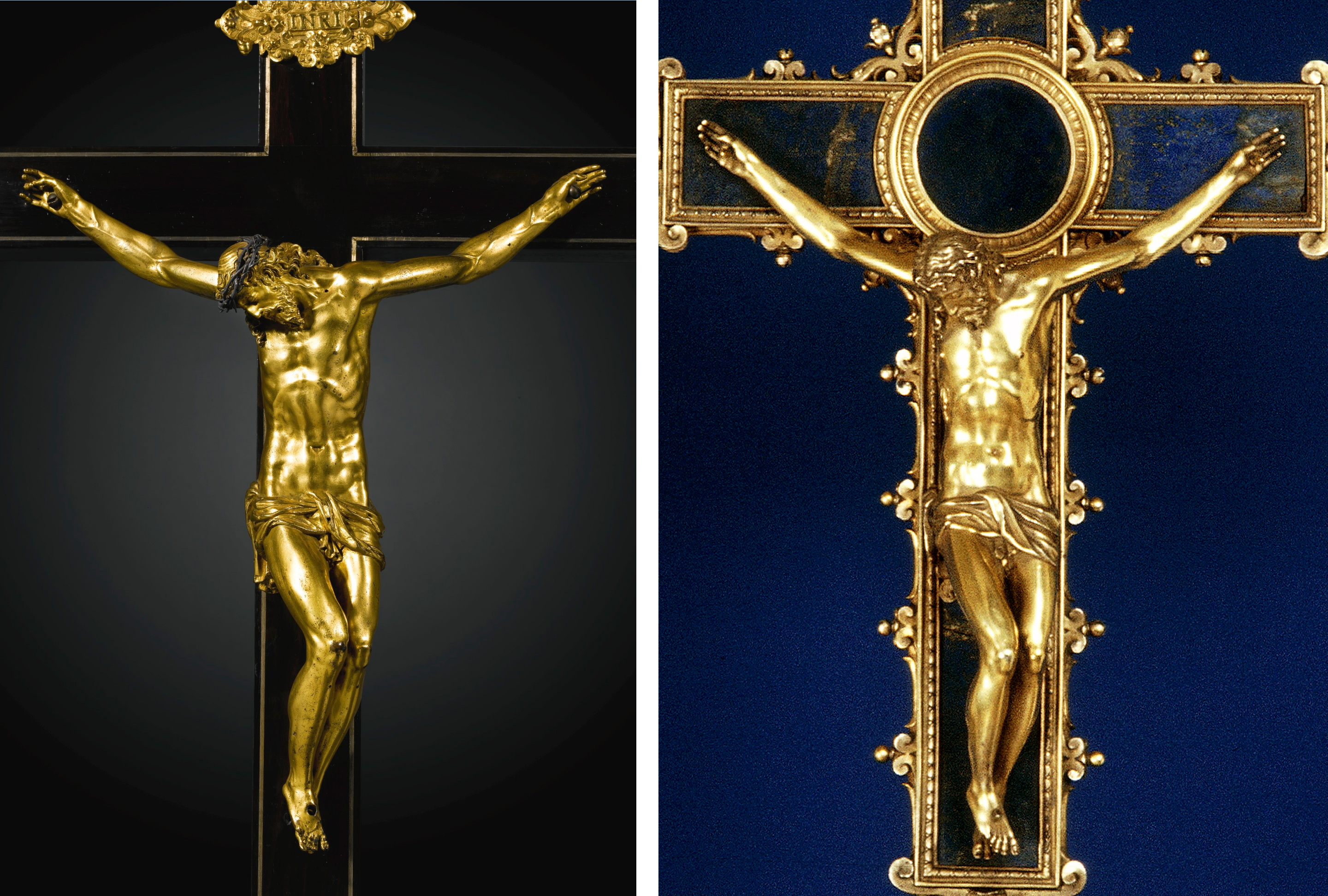
However, the corpus-type associated with the Loreto crucifix, currently recognized as the earliest crucifix model made by Giambologna, actually reproduces a model originally conceived by Guglielmo by the year 1571 for Cardinal Alessandro Farnese (1520-89) and embellished by Gentili. A letter of gratitude, delivered in 1571 from Alessandro to Guglielmo, offered praise for the crucifix he had received from him.[20] It is the model for this crucifix that is understood to have been later reproduced and cast by Gentili for inclusion on the Farnese altar cross completed in 1582 and donated by Alessandro to St. Peter’s Basilica in 1583 (Fig. 03, right).[21] [22] A previously unpublished corpus fixed to an altar cross historically belonging to the Capponi family in Rome preserves the original untreated model by Guglielmo, probably analogous to the one received by Alessandro in 1571 (Fig. 03, left). Its incredible quality and exquisite detail evinces its contemporaneous casting. Christ’s dynamic figure, expressed with muscular drama, along with his disheveled hair, suggests the nervous mode articulated in Guglielmo’s sketched works and establishes it as a prototype by him (Fig. 04).[23]
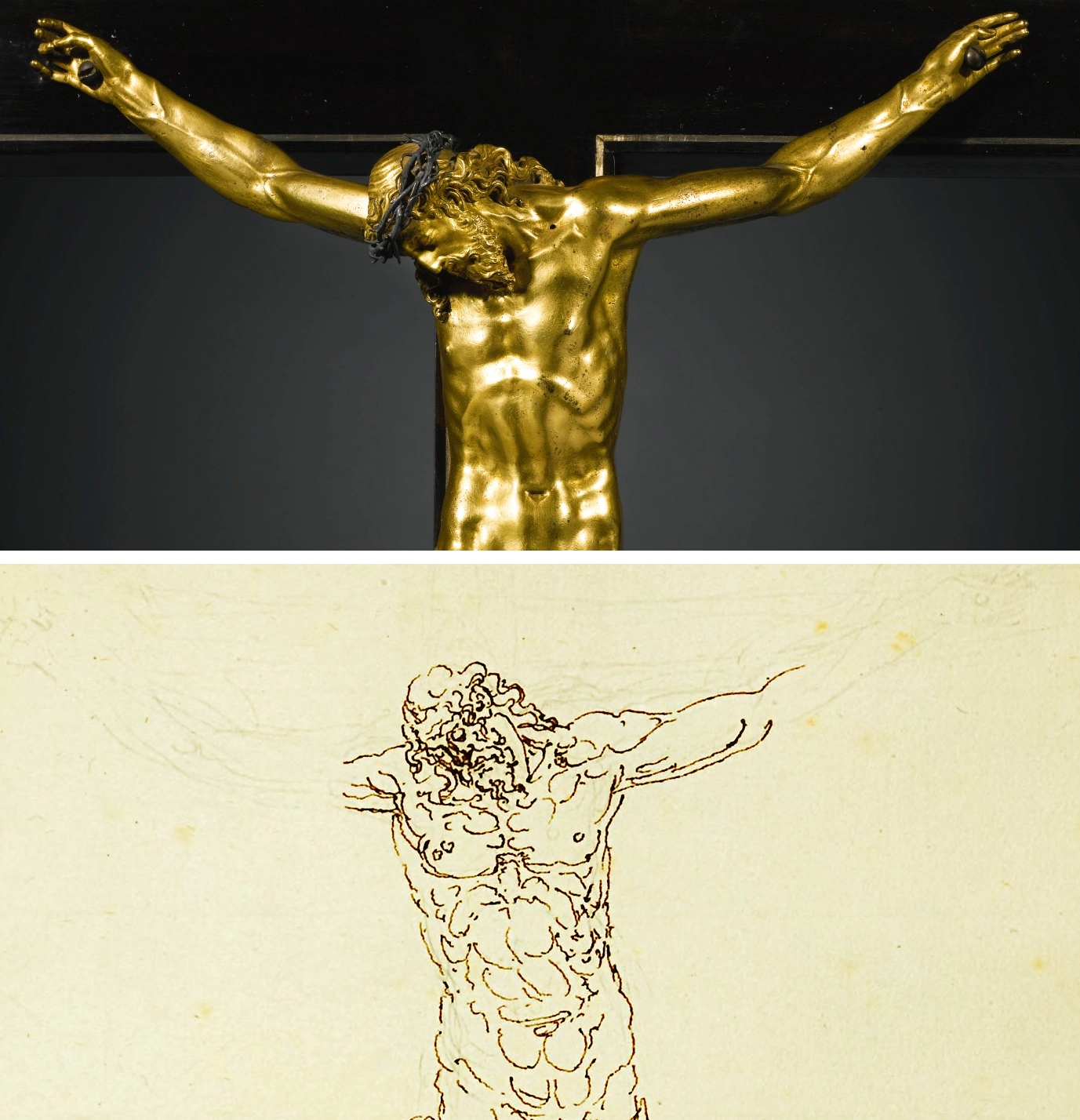
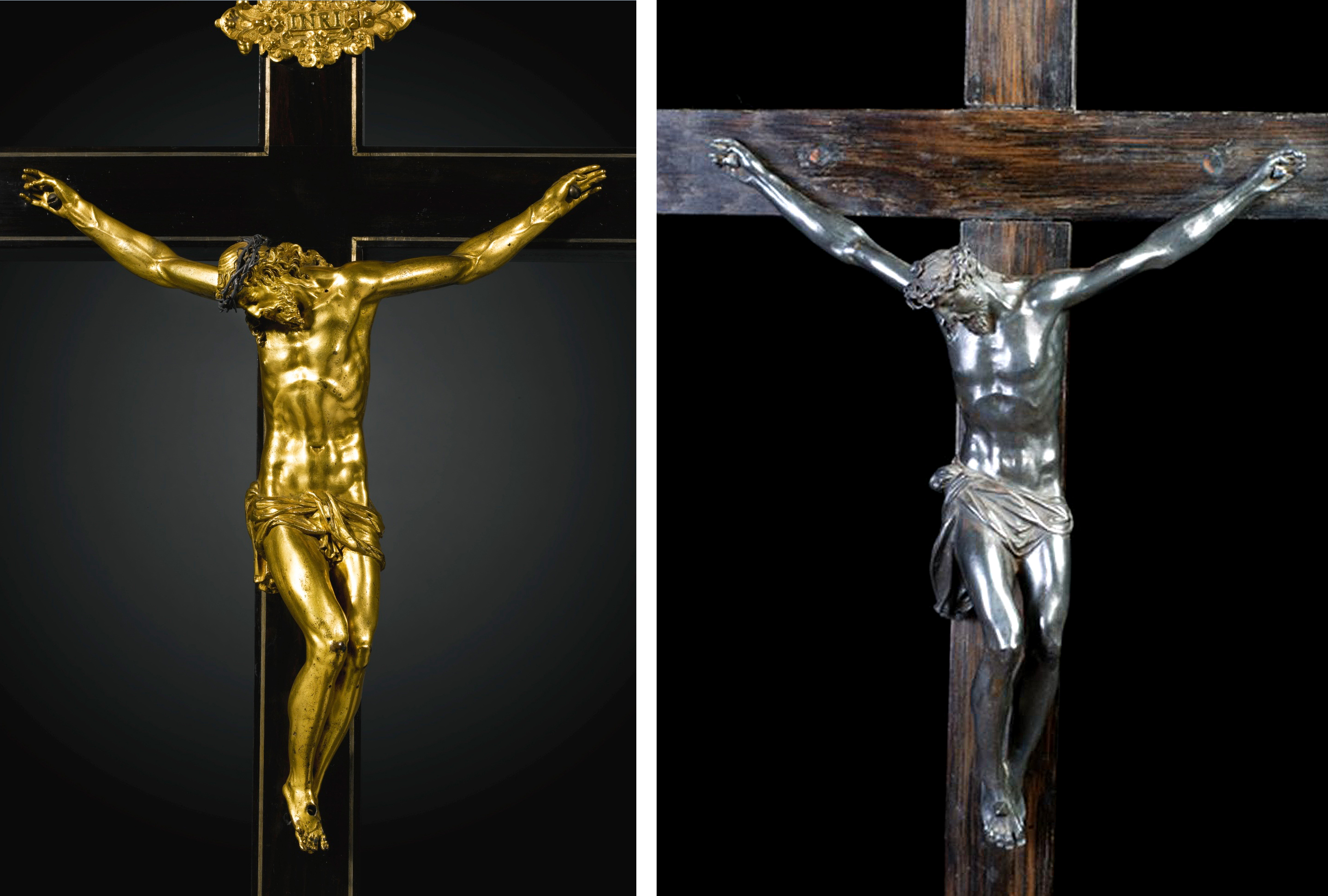
The Loreto crucifix exhibits some of these same modifications to Guglielmo’s prototype model while others are left intact (Fig. 05). For example, Christ’s proper right hand retains the sign of blessing, the arms are not raised higher and the position of his head is unaltered. However, the features are again softened and the hair is similarly remodeled. The torso of Christ is further tucked which results in a slightly smaller height for the corpus, an approximate 3 cm reduction, some of which may be accounted for due its derivation from an earlier model.[24] The most profound alteration, however, is the perizonium which is completely remodeled and drapes down the back of Christ’s proper right leg. The perizonium is more conservative in its covering and is a casual modification to the wax model considering it covers rather than reveals the anatomy already rendered in the original prototype. The perizonium of the Loreto crucifix follows the type Guglielmo employed for the smaller scale models of Christ featured on his Mount Calvary reliefs datable ca. 1570-75 (Fig. 06) and suggestive of the period in which the Loreto crucifix may have been conceived.[25] [26]

The evidence of Guglielmo’s prototype, worked upon and cast by Gentili verifies the Loreto crucifix is not the invention or work of Giambologna but instead represents one of several workshop variations based upon Guglielmo’s 1571 crucifix for Alessandro Farnese.
THE PRODUCTION OF CRUCIFIXES IN GUGLIELMO’S WORKSHOP
While its implied that Giambologna was modeling and casting crucifixes by 1572 it is certain Guglielmo’s workshop was serially producing them during the 1570s, notable by Alessandro Farnese’s request for “some crucifixes made of solid silver and other gilt metals” for St. Peter’s Basilica in 1569[27] and by the quantity of crucifixes in various stages of production left at the time of Guglielmo’s death in 1577. His posthumous inventory counts at least 58 examples, finished and unfinished and ranging in size from approximately 22 to 70 cm.[28]
If the crucifix in Loreto was part of the altar service donated by Joanna in 1573 it is possible the group could have been the product of Guglielmo’s workshop who were proficient in the production of crucifixes by 1569 and possibly as early as 1560 when Guglielmo turned his concentration toward religious subjects rather than classical ones.[29] In particular, Gentili possibly had an active role in completing crucifixes on behalf of Guglielmo. In 1570 he was entrusted to execute twelve reliquary busts for Pope Pius V (1504-72) using Guglielmo’s designs. All indications point to a period, ca. 1570, when a crucifix like the Loreto example would have been cast and allowing reasonable time for an example to reach Joanna before her visit to Loreto in 1573.
As previously noted, it is established that Giambologna’s assistants were involved in making casts of crucifixes using his models. Derivations typically involved the embellishment of facial characteristics, hair, perzoniums, the lowering and raising of legs and arms, adjustments to the position of fingers and distinctions in the finishing of the casts through chasing, burnishing and gilding. The aforementioned features are adjustable in newly cast wax models taken from original molds within a workshop. A quantity of crucifixes finished by Giambologna’s assistant, Antonio Susini, are known, such as an example at the Convent of San Marco in Florence, believed cast and finished by his hand but reproducing the model Giambologna used for the Convent of Santa Maria degli Angiolini in Florence before 1588 (Fig. 02).[30] Other embellished crucifixes attributed to Susini are known such as a group cast after a Cristo Vivo model attributed to Giambologna.[31] However, not thoroughly examined is Guglielmo’s similar practice among his own colleagues. In consideration of the numerous crucifixes in Guglielmo’s workshop at the time of his death, and considering also his elder years during the 1570s, it is unlikely he would have been as personally involved in the production of these casts but rather would have delegated a reasonable sum of them to his assistants. It is further sensible that he may have desired some diversification of his models having devoted his workshop to the production of crucifixes in qualifying numbers and perhaps preferring distinctions among them.[32] [33]
SEBASTIANO TORRIGIANI AND GUGLIELMO’S CRUCIFIX PROTOTYPE
Guglielmo’s colleague Sebastiano Torrigiani (d. 1596) probably worked upon and cast crucifixes in Guglielmo’s workshop as well. He certainly reproduced his models after inheriting Guglielmo’s workshop following his death.[34] For example, Torrigiani cast the same Gentili-treated crucifix featured on the Farnese altar cross (Fig. 03, right) for an altar cross he produced for Pope Gregory XIII (1502-85) in 1583, also donated to St. Peter’s Basilica, where it is today displayed in the same room as Gentili’s altar service for Alessandro Farnese.
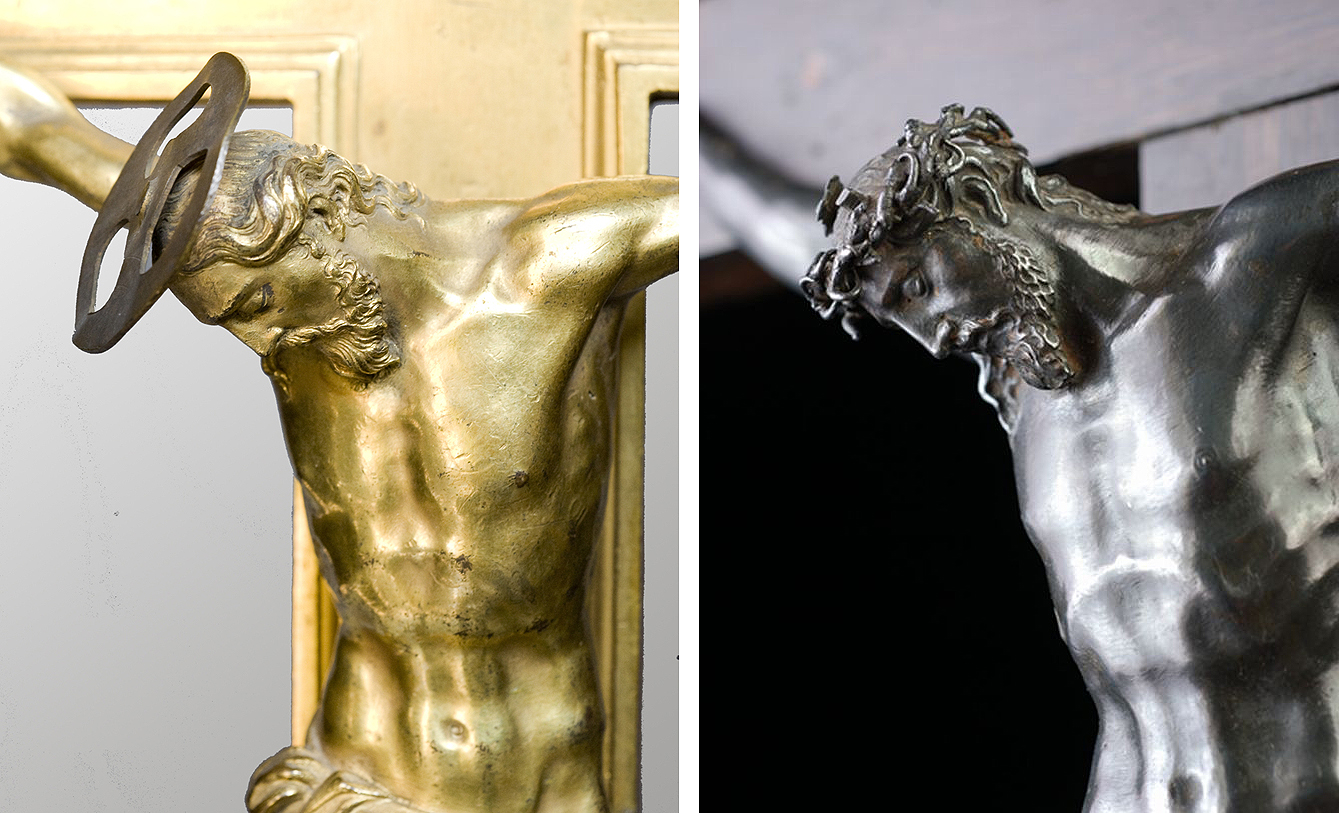
An additional and earlier gilt bronze crucifix was reproduced by Torrigiani in 1581 for the altar service of San Giacomo Maggiore in Bologna, also commissioned by Pope Gregory XIII. This crucifix has its antecedent in Guglielmo’s 1571 Farnese prototype but instead uses Gentili’s treated Loreto variant as its primary model (Fig. 07), evident by the modestly raised arms, subdued anatomical detail, alternative umbilicus and remodeled perizonium. However, further embellishments have been introduced. The perizonium is less windswept and hangs slightly longer along Christ’s proper right leg and its knot does not wilt but is taut and rounded. The most evident alteration is a complete replacement of Christ’s head and hair whose manner is informed of Guglielmo’s influence but is more austere yet prevailing than the intense expressiveness observed in Guglielmo’s models. It is presumed these embellishments are Torrigiani’s own invention upon his master’s model. Further evidence for this idea is found by the inclusion of this same corpus-model for the Crucifixion panel (Fig. 08) on the Sta Maria Maggiore (Rome) tabernacle executed by Torrigiani and Ludovico del Duca between 1587-89. It has traditionally been understood that Ludovico was exclusively responsible for the tabernacle’s ciborium,[35] though Torrigiani appears to have shared some of his models for use on the ciborium, such as the winged putto appliques set within the triangular pediments along its central tier.[36] The incorporation of Torrigiani’s San Giacomo Maggiore crucifix on the Sta Maria Maggiore tabernacle Crucifixion panel reassures his personal intervention on Guglielmo’s model while likewise distancing it from any further connection with Giambologna.

An even later treatment to Torrigiani’s adapted crucifix is found on a unique silvered bronze example in the Grimaldi Fava collection (Fig. 09). This version shows a weakening of detail on the body of Christ, being a vestige of Guglielmo’s original model, but the extremities, perizonium and face retain a freshness expected with Torrigiani’s edits. The distinguishing feature of the Grimaldi crucifix is its adjusted hair and beard which are revitalized with a particular energy that recalls the influence of Guglielmo’s manner.[37] In spite of the embellishment, the hairline of the beards on the San Giacomo Maggiore and Grimaldi crucifixes still maintain the same non-linear curls that emerge and descend like waves along Christ’s face (Fig. 10). On the Grimaldi crucifix the volume of Christ’s hair has been strategically enhanced over the earlier model where it descends behind his head, along the neck and terminates in bulbous curls that form almost complete circles. The embellishments featured on the Grimaldi crucifix may still belong to Torrigiani’s intervention. The addition of grooved and spiraling hair with its voluminous terminating curls recalls that of the near life-size angels Torrigiani executed for the Sta Maria Maggiore tabernacle in Rome (Fig. 11).
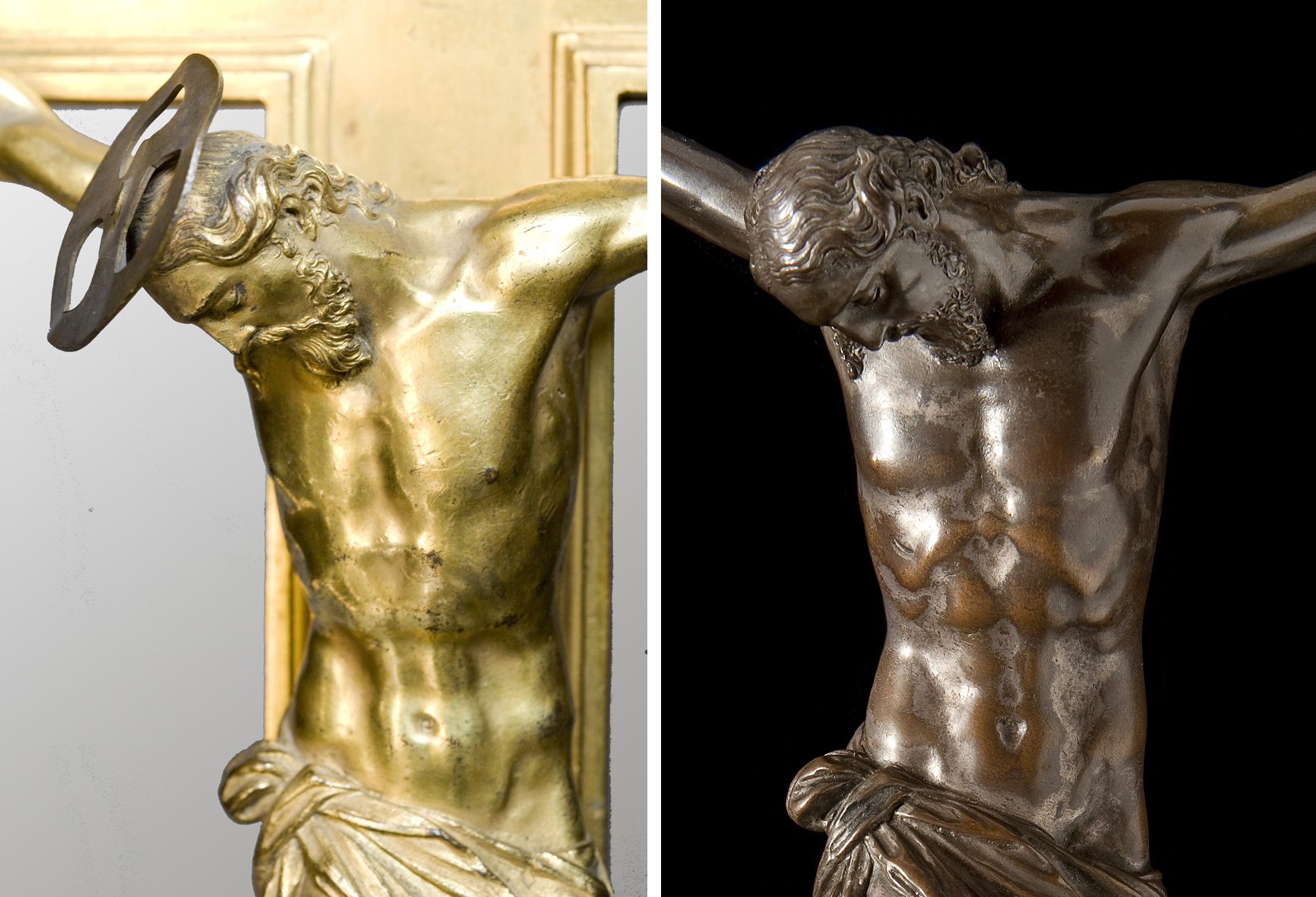
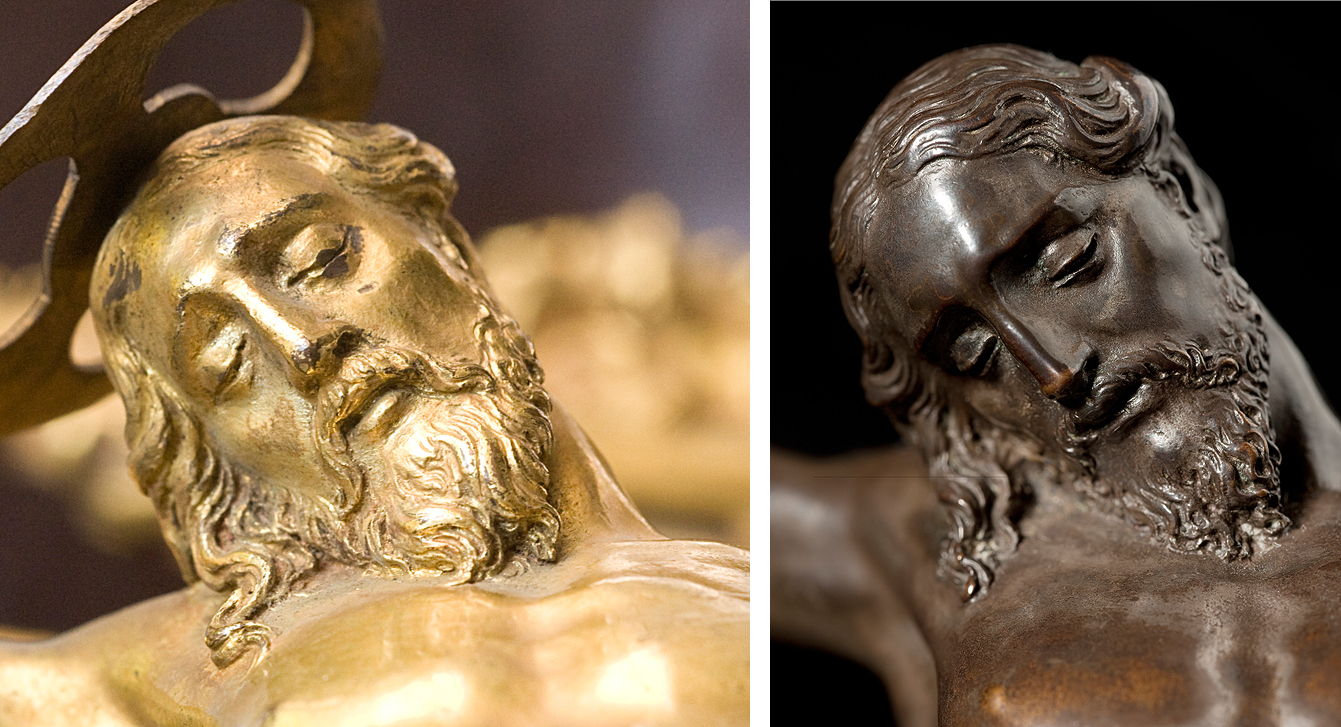
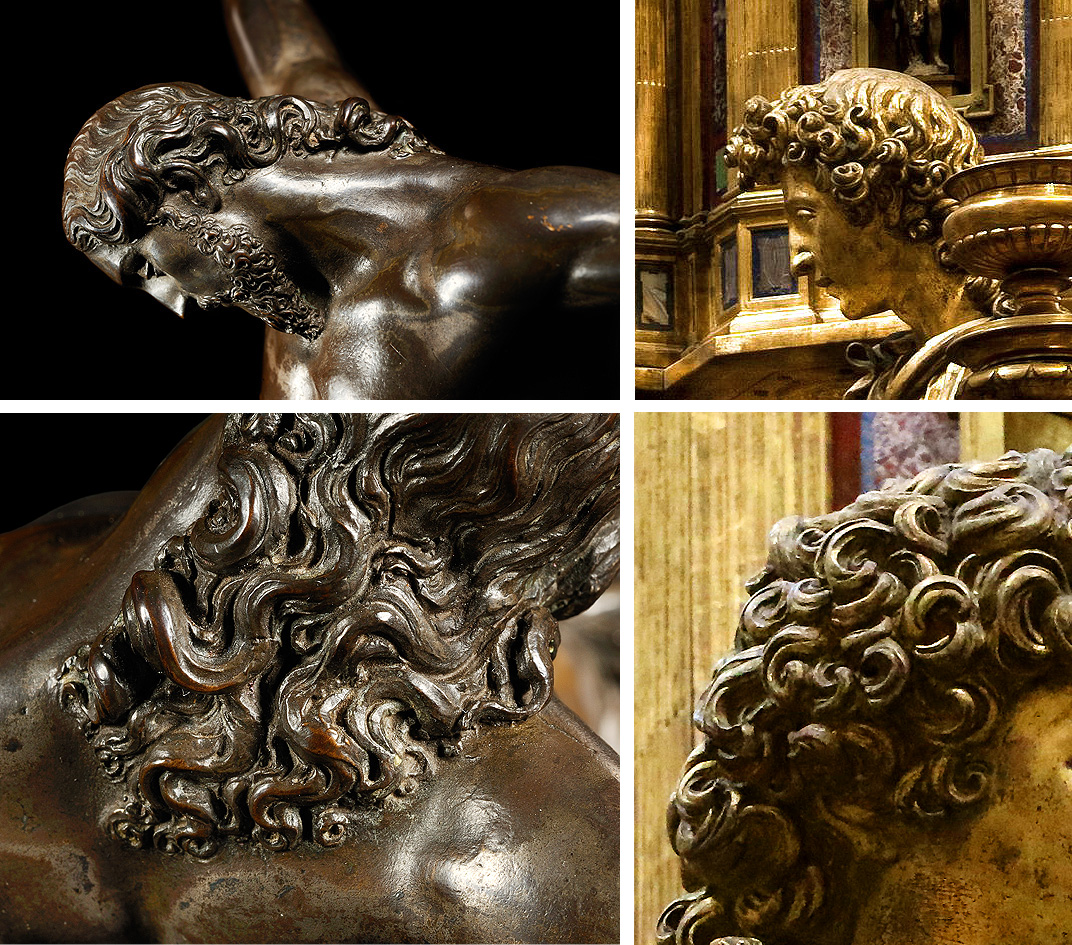
Since Torrigiani did not choose to reproduce the modified Grimaldi-type crucifix on the Sta Maria Maggiore Crucifixion panel this version could date to a period after its completion, ca. 1590-96. It is worth noting that no blood appears on the side-wound of Christ on the Grimaldi crucifix, favoring the type of bloodless Christ likewise found on some later casts made from Guglielmo’s models and also lacking on Giambologna’s crucifixes of the 1590s, probably indicating a shift in the taste and theological climate of the period.
If the aforementioned discussion of Guglielmo’s crucifix prototype and its descendants, inclusive also of the Loreto-type, is not enough to dissuade an association with Giambologna then further stylistic differences may also be drawn to support the distinction between the two sculptors.
Already noted is the umbilici depicted on Guglielmo’s models, rendered naturally in an inverted triangular shape and close to the surface of the abdomen while Giambologna’s crucifixes feature a deeply recessed umbilicus with the surrounding skin stretched tight around it. In similar manner, the chest of Guglielmo’s crucifixes are rendered with an elaborate and natural display of musculature while Giambologna’s are less commanding in their form and feature a tension that highlights the sternum and costal cartilages (Fig. 12). Further, the aureole and nipples on Giambologna’s crucifixes are formed conically to a sharp point while Guglielmo’s are sculpted with a raised, flat aureole.

The representation of hair is very different between both sculptors and their assistants. For example the hair depicted on Giambologna’s crucifixes for the Grand Duke Ferdinando I of Bavaria (Fig. 12) and the Chapel of the Madonna del Soccorso in the Basilica of Santissima Annunziata (Fig. 13, left) is thickly modeled and sits atop the head of Christ as though it were modeled separately and attached like a helmet but whose thick locks fall over the forehead in realistic fashion, while the hair depicted on Guglielmo’s crucifixes is characterized in low relief along the forehead and receives volume as it descends along the sides and over the head with a particular suave. The delineation of hair along the cheeks of Giambologna’s crucifixes are realized by downward strokes, forming a linear trim for the beard while Guglielmo’s are instead defined by cascading curls of hair that flow in a non-linear manner along the sides of Christ’s face.

The mood characterized by the Grimaldi crucifix probably owes its likewise mistaken identity as a work by Giambologna due to the features it shares with his large crucifixes from the 1590s (Fig. 13). The similarly shaped beard and dense, detailed curls along Christ’s cheeks, though less complete in their circular foray, offer an immediate correspondence, as does the delineation of hair atop the head and the superficial relationship of the hair tucked behind Christ’s ear. The facial modeling also shares several of the same plain and smooth features observed on Giambologna’s crucifixes. However, Torrigiani’s crucifixes diverge by incorporating a pursed brow unlike the perfectly arched brow line featured on Giambologna’s models. More subtle distinctions are apparent on the nose of Christ whose character on Giambologna’s crucifixes are perfectly straight and smooth while Torrigiani’s slightly expand at the bridge of the nose.
RECONSTITUTION OF GUGLIELMO’S CRUCIFIX PROTOTYPE
Ultimately, we find in Giambologna’s crucifixes a strict, polished and purified depiction that is very clean in its order and presentation whereas Guglielmo’s school of crucifixes are anatomically intense and natural, owing to his admiration of Michelangelo (1475-1564). In sum, we may observe the manner in which Guglielmo’s collaborators treated his crucifixes as parallel to the way in which Giambologna’s collaborators likewise worked upon his models.
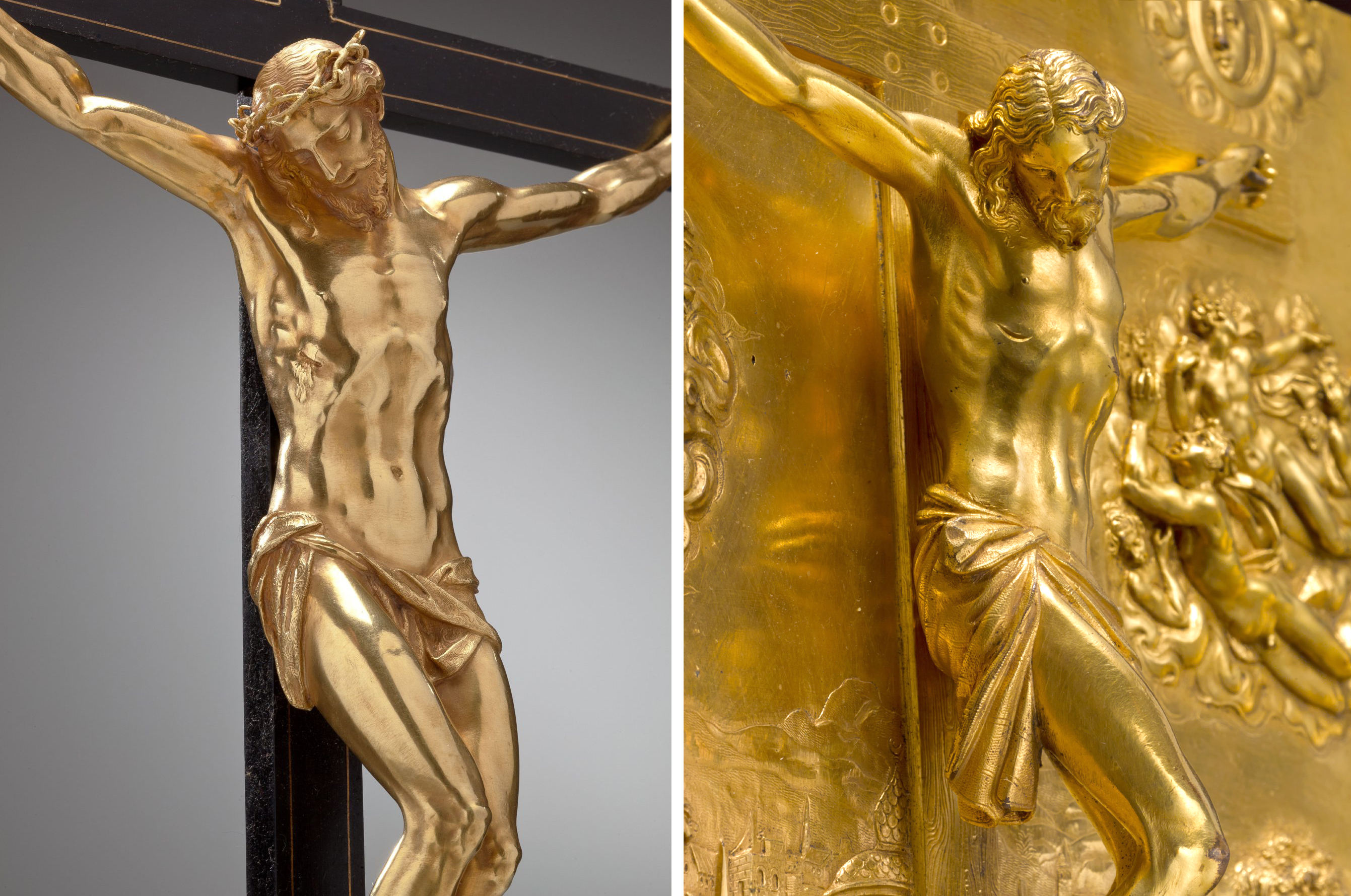
The realignment of the Loreto crucifix with an origin in Guglielmo’s workshop will necessitate adjustments to the art history surrounding its association with Giambologna. Most recently a group of small and exquisite gold crucifixes have been connected to Gaspara Mola, thought to be based upon Giambologna’s crucifixes due to its association with the Loreto crucifix. As discussed by Andrea di Lorenzo, the inventories of Ferdinando I de’ Medici (1549-1609) and Cosimo II de’ Medici (1590-1621) document gold crucifixes based on models by Giambologna but their recorded sizes exceed the height of the group he attributes to Mola, and suggests the Mola crucifixes could be a reduction of the larger models.[38] However, the Mola group corresponds not only to Giambologna’s models but to those used in particularly small scale for Guglielmo’s Mount Calvary reliefs (Fig. 14). While there are liberties taken for the treatment of the perizonium, face and hair, the Mount Calvary model relates to the Mola group by way of their scale and general type, being approximately 20 cm in height versus the 16-17 cm height observed on the Mount Calvary corpora.
Another important altar service incorporating rock crystals and gilt bronze embellishments at the Basilica della Santissima Annunziata in Florence should also be reconsidered as derivative of Guglielmo’s circle. It features a gilt bronze version of the Loreto crucifix and is currently attributed to Pietro Tacca (1577-1640) likely due to his activity in Giambologna’s workshop.
ENDNOTES
1. Rosario Coppel (2012): Guglielmo della Porta in Rome. Guglielmo della Porta, A Counter-Reformation Sculptor. Coll & Cortés, pp. 28-57.
2. For a discussion of the cultural environment within which Guglielmo’s workshop operated see C.D. Dickerson III (2008): The “Gran Scuola” of Guglielmo della Porta, the Rise of the “Aurifex Inventor” and the Education of Stefano Maderno. Storia dell’arte, 121, pp. 25-71.
3. Katherine Watson (1978): Giambologna, 1529-1608, Sculptor to the Medici. Arts Council of Great Britain. No. 106, p. 144.
4. Katherine Watson (1978): The Crucifixes of Giambologna. Giambologna, 1529-1608, Sculptor to the Medici. Arts Council of Great Britain, pp. 45-47.
5. Joanna’s visit is documented between 18 April and 9 May of that year (1573). See K. Watson (1978), op. cit. (note 4).
6. This source is in the archival notices in Loreto, collected by Settimani and Lapini. See K. Watson (1978), op. cit. (note 3).
7. K. Watson (1978), op. cit. (note 4).
8. Joanna would have presumably received her crucifix from Giambologna any time between 1572-78.
9. It is assumed Joanna received a silver crucifix from Giambologna but a bronze example may have been equally possible according to Fortuna’s letter.
10. Charles Avery (2014): Giambologna’s Images of the Crucified Christ. Altomani & Sons.
11. Around 1580 Giambologna is also documented as giving a crucifix to Bartolomeo di Lionardo Ginori who had served as a model for Giambologna’s Rape of the Sabine Women marble. See C. Avery (2014), op. cit. (note 10).
12. A Cristo Vivo model attributed to Giambologna is accepted as his work, a fine example of which is in Santissima Annunziata in Florence, proposed by Eugenio Casalini as datable also to 1578 although Herbert Keutner suggested its inception is more aligned with Giambologna’s crucifixes of the 1590s. See K. Watson (1978), op. cit. (note 3), No. 98, p. 140.
13. K. Watson (1978), op. cit. (note 4).
14. K. Watson (1978), op. cit. (note 3), No. 105, p. 143.
15. K. Watson (1978), op. cit. (note 3), No. 107, p. 144. This corpus is documented involving Giambologna’s assistant, Antonio Susini, whose characteristic finishing is present on the cast.
16. Gramberg’s own private example of the crucifix was published and discussed in: Werner Gramberg (1961): Sechs Sammler Stellen Aus. Museum für Kunst und Gewerbe Hamburg, No. 43. Gramberg considered the model as Guglielmo’s but cast and finished by Antonio Gentili da Faenza due to its comparable quality with a corpus featured on a Mount Calvary relief panel in the bed chamber of King Phillip II at El Escorial in Madrid which is thought to have been cast by Gentili (see Werner Gramberg [1973]: Das Kalvarienbergrelief des Guglielmo della Porta und seine Silber-gold-Ausführung von Antonio Gentili da Faenza. Intution und Kunstwissenschaft. Festschrift für Hans Swarzenski. Berlin, pp. 449-60).
17. Ulrich Middeldorf (1980): Palazzo Vecchio: committenza e collezionismo medicei, Firenze e la Toscana dei Medici nell ‘Europa del Cinque cento. Florence. No. 674.
18. Anna Beatriz Chadour (1982): Der Altarsatz des Antonio Gentili in St. Peter zu Rom. Wallraf-Richartz-Jahrbuch, vol. 43, pp. 133-93 (see especially pp. 171-72).
19. Chadour compares the Gramberg crucifix to the one Gentili cast for the Farnese altar cross in 1578, now in the Sacristy of St. Peters at the Vatican and another cited by Gramberg (see note 14) featured on a Mount Calvary relief kept in the bed chamber of Philip II in the Monastery of El Escorial in Spain which uses a smaller scale model conceived in Guglielmo’s workshop .
20. Alessandro’s letter to Guglielmo was written on 8 December 1571 stating: “I have received the crucifix that it was your pleasure to send me and because it is a work of such merit and made with so much care and diligence by such a perfect hand as your own, it has pleased me so much, to the furthest extent to which I can express myself, and indeed I know not of any image that could be sculpted with greater mastery and more skill than this one, so the greater is my gratitude to you.” (from the State Archives of Naples, first published by Gramberg in 1981 and reproduced by R. Coppel in 2012
(see note 23).
21. The crucifix Guglielmo made for Alessandro was subsequently recast and fixed to an altar cross completed by Gentili in 1582, now located in the Treasury of St. Peter’s Cathedral (See Rosario Coppel [2012]: Guglielmo della Porta in Rome. Guglielmo della Porta, A Counter-Reformation Sculptor. Coll & Cortés, pp. 28-57). Further evidence associating this corpus-type with Guglielmo is found in documents concerning the trials initiated by his son, Teodoro della Porta, in which a testimony is given by Giovanni Battista Montano, who infers Gentili’s use of Guglielmo’s crucifix model for the Farnese altar cross (see A.B. Chadour [1982], op. cit. [note 18]).
22. Guglielmo’s other collaborator, Sebastiano Torrigiani also reproduced this same crucifix after Guglielmo’s model in gilt bronze for an altar cross also donated to St. Peters Basilica and commissioned by Pope Gregory XIII in 1583. See A.B. Chadour (1982), op. cit.
(note 18).
23. A larger crucifix alike in its form and character, also accepted as a contemporaneous crucifix by Guglielmo (Fig. 12, right), was offered by Coll & Cortés Fine Arts in 2012. See Rosario Coppel (2012): Catalogue (Christ Crucified). Guglielmo della Porta, A Counter-Reformation Sculptor. Coll & Cortés, pp. 62-73.
24. For example, compare the height of the Farnese altar corpus at 26.6 cm versus the Loreto corpus at 23.8 cm.
25. Rosario Coppel (2012): Catalogue (Mount Calvary). Guglielmo della Porta, A Counter-Reformation Sculptor. Coll & Cortés, pp. 98-111.
26. Just like Guglielmo’s crucifixes, his Mount Calvary reliefs may be ascribed to him or members of his workshop. For example, the Mount Calvary at the Budapest Museum of Fine Arts is likely the workmanship of Guglielmo (see Miriam Szöcs [2013]: From Hans Reichle to Guglielmo Della Porta. Bulletin du Musée Hongrois des Beaux-Arts. Budapest, pp. 129-47) save for the crucifix which may have been treated by an assistant. The Mount Calvary example in Phillip II’s bedchamber at El Escorial and another sold by Coll & Cortés Fine Arts (see R. Coppel [2012], op. cit. [note 25]) can be accepted as casts executed by Gentili.
27. G.B. Chadour (1982), op. cit. (note 18), see footnote 135.
28. R. Coppel (2012), op. cit. (note 23).
29. R. Coppel (2012), op. cit. (note 21).
30. K. Watson (1978), op. cit. (note 3), see No. 105 for Giambologna’s cast and No. 107 for Susini’s cast.
31. K. Watson (1978), op. cit. (note 3), see Nos. 98-100 for versions attributed to Giambologna and Nos. 101-03 for versions attributed to Susini.
32. The liberty given to Guglielmo’s assistants is elaborated upon in C.D. Dickerson’s summary of the studio’s culture in which artists were “encouraged to give voice to their own creative impulses,” setting a tone that was “conducive to creativity,” unlike other workshops active in Rome at the time. See C.D. Dickerson (2008), op. cit. (note 2).
33. For example, Teodoro della Porta indicates Guglielmo worked on a Descent from the Cross wax model in collaboration with Jacob Cornelisz Cobaert stating, “Almost three palms in size of high and bas relief, with many figures inside, beautifully sculpted by the hand of my father, with Coppe Fiamingo (Cobaert) also being involved in this work.” See Antonino Bertolotti (1881): Artisti lombardi a Roma, II. Milan, p. 129.
34. For example, see Baldo Vazzano’s testimony in the 1609 trial initiated by Teodoro whose comments note that “Bastiano had crucifixes and models to make crucifixes, molds and wax models of different figures.” See A. Bertolotti (1881), op. cit. (note 33), pp. 157-61.
35. For a detailed discussion on the creation of the Sta Maria Maggiore (Rome) tabernacle see Jennifer Montagu (1996): Gold, Silver & Bronze: Metal Sculpture of the Roman Baroque. Princeton University Press, pp. 24-28.
36. The use of another sculptor’s creations on Ludovico del Duca’s responsible portion of the project would not be unusual since Ludovico himself borrowed his brother Jacopo del Duca’s molds for the relief panels on the ciborium. See J. Montagu (1996), op. cit. (note 35).
37. The waxy quality of the beard and its unique embellishments may be due to a flaw realized while preparing the wax model where the region was tempered with heat and manipulated with the tools of the artist’s hand, possibly by an assistant in Torrigiani’s workshop, while the updated hair may have already formed part of the mold conceived by Torrigiani from which the wax model derived. The proper right cheek of Christ’s face, pressed against his chest, for example, does not show the same degree of treatment to the beard.
38. Andrea di Lorenzo (2011): Il Crocifisso d’oro del Museo Poldi Pezzoli, Giambologna e Gasparo Mola. Museo Poldi Pezzoli, Milan.

Leave a comment